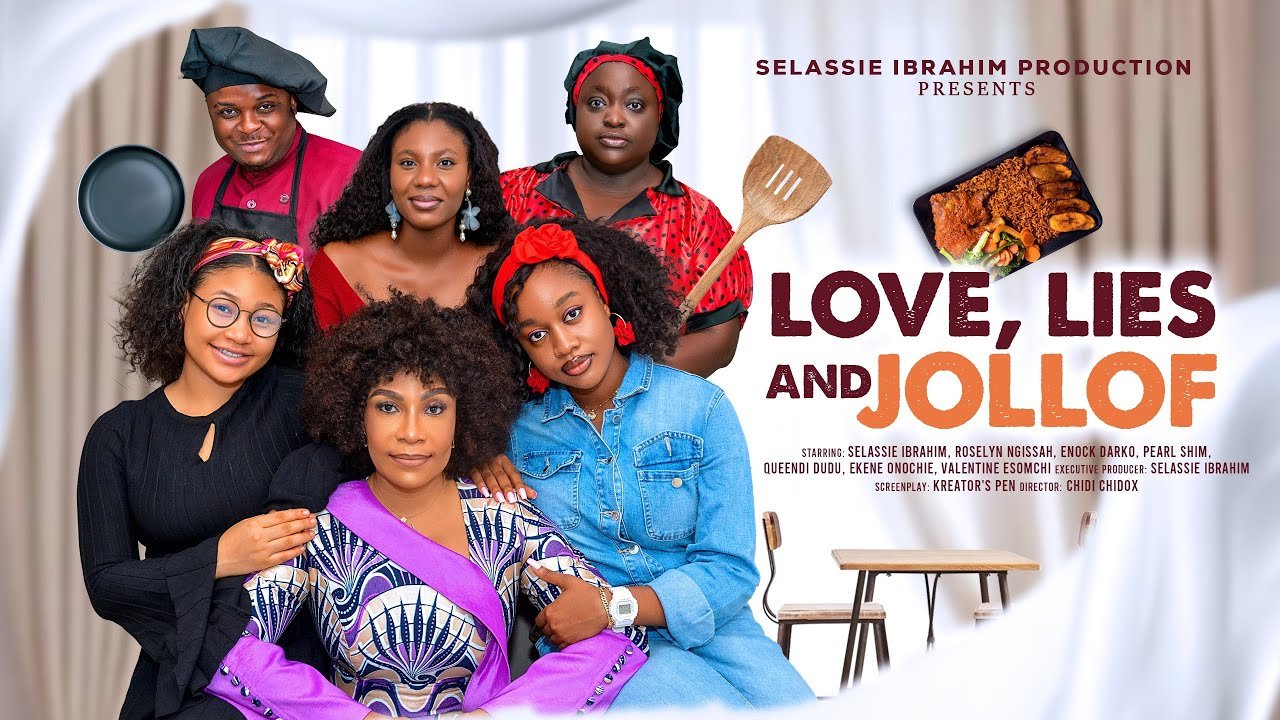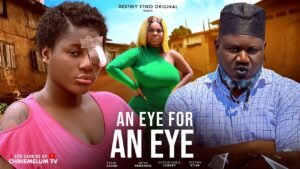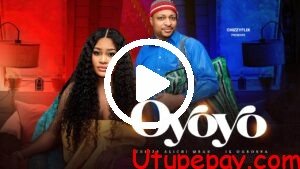
Love, Lies, and Jollof: Exploring the Intricacies of Relationships in the Newest Movie
CLICK HERE TO WATCH
Introduction to Love, Lies, and Jollof
Love, Lies, and Jollof is a cinematic exploration that delves into the complexities of relationships, interwoven with the rich cultural backdrop of Nigerian society. This film captures the essence of love in its various forms—romantic, platonic, and familial—while skillfully addressing the ramifications of deceit and the pursuit of truth in personal connections. Set against the vibrant, culinary-themed title, “Jollof” signifies more than just a beloved dish; it represents the fusion of emotions and experiences that define relationships. The film’s title itself evokes warmth, community, and the universally appealing aspects of sharing meals, making it relatable to a wide audience.
At the heart of Love, Lies, and Jollof lies a narrative that underscores the importance of communication and honesty among individuals. The primary concept revolves around a group of friends whose lives become entwined through love affairs, secrets, and aspirations, ultimately reflecting the intricate tapestry of contemporary relationships. The film artfully navigates the balance between romantic commitments and familial expectations, creating a resonant commentary on the struggles faced by many in navigating their personal lives.
The movie has garnered attention not only for its engaging storyline but also for its representation of cultural elements specific to Nigerian life, including language, traditions, and the sociocultural dynamics that shape relationships. Love, Lies, and Jollof invites viewers to reflect on the nature of trust and vulnerability as it explores how characters deal with the repercussions of their choices. As audiences embark on this cinematic journey, they are encouraged to ponder not only the challenges that arise in love but also the significance of honesty in nurturing meaningful connections.
Meet the Cast: Selassie Ibrahim, Roselyn Ngissah, Enock Darko, and Pearl Shim
In “Love, Lies, and Jollof,” a captivating exploration of love and relationships, the film’s depth is significantly attributed to its talented cast. Leading the ensemble is Selassie Ibrahim, known for her versatile performances across various genres. With a career spanning over a decade, she has made notable contributions to both film and television. Her role in this film presents her as a relatable character navigating the intricate paths of romance and self-discovery. Selassie’s acting style is characterized by a naturalistic approach that allows her to authentically embody the emotions of her character, engaging audiences effectively.
Joining her is Roselyn Ngissah, a seasoned actress recognized for her riveting performances in West African cinema. Often celebrated for portraying strong, complex women, Roselyn brings depth to her character in “Love, Lies, and Jollof.” Her previous works include acclaimed dramas where she displayed a mastery of balancing vulnerability and strength, making her a compelling presence on screen. This film allows her to delve into the nuances of relationships, showcasing her ability to captivate viewers with her immense talent.
Enock Darko, a rising star in the industry, also lends his talents to the film. Known for his engaging screen presence and charismatic performances, Enock has been involved in several successful projects that demonstrate his dynamic range as an actor. His portrayal in this film plays a crucial role in the narrative progression, adding layers to the storyline and enhancing the emotional resonance of the film.
Lastly, Pearl Shim, an actress with a unique flair, rounds out the principal cast. Her previous roles have highlighted her ability to bring complexity to light-hearted characters, an essential trait for the dynamic she navigates in “Love, Lies, and Jollof.” Pearl’s performance is pivotal, as she adds humor and warmth, balancing the film’s more intense moments. Together, these talented individuals contribute to a rich tapestry of storytelling that invites viewers into the heart of the film’s exploration of love and relationships.
Plot Overview and Key Themes
‘Love, Lies, and Jollof’ unveils a narrative rich with emotional depth and cultural significance, primarily revolving around the intricate dynamics of relationships within a contemporary Nigerian setting. The film follows the lives of three main characters—Nia, Tunde, and Zara—whose intertwined destinies bring to the forefront themes of love, betrayal, and self-discovery.
<pthe a=”” also=”” ambitions,=”” an=”” anchor.=”” and=”” as=”” aspiring=”” at=”” becomes=”” both=”” but=”” by=”” charming=”” chef,=”” conflict.
As events unfold, the film delves into the complexities of love—highlighting the boundaries that are often blurred between loyalty and desire. The cultural significance of jollof rice becomes a recurring motif, symbolizing not just culinary heritage but also a means of connection and discord among the characters. It is through the preparation and sharing of this beloved dish that the characters confront their truths and the results of their choices.
In addition to exploration of love and betrayal, ‘Love, Lies, and Jollof’ interrogates themes of authenticity and self-identity. As the characters grapple with their desires and the expectations placed upon them, the narrative ultimately advocates for honesty in relationships, emphasizing the notion that true connection can only be forged through transparency. Through its engaging plot and rich character arcs, the film exemplifies how love and culture intersect, using jollof rice as a vivid representation of unity and division within relationships.
Cultural Significance: Jollof as a Symbol
Jollof rice, a vibrant staple in West African cuisine, extends beyond mere sustenance; it embodies the rich cultural tapestry of the region. In the context of the film “Love, Lies, and Jollof,” jollof serves as a powerful metaphor, encapsulating the intricate dynamics of relationships among the characters. The preparation and sharing of this beloved dish evoke a sense of connection, celebration, and sometimes, conflict, making it a crucial element in the narrative.
Throughout the film, jollof rice becomes a focal point in key scenes, reflecting the characters’ emotional journeys. One notable moment occurs during a family gathering, wherein the preparation of jollof rice brings the characters together, showcasing their love and unity. The aroma wafts through the air, serving as a reminder of their shared heritage and the bonds of family. As they gather around the table, it is evident that food plays a significant role in nurturing relationships, reinforcing their connection to each other and their cultural roots.
Conversely, jollof rice also symbolizes conflict within the film. The famous jollof rivalry among West African countries becomes a backdrop for a heated debate during a pivotal gathering, illustrating how food can evoke strong emotions and differing opinions. This scene resonates with audiences, as it reflects not only the playful culinary rivalry but also the underlying tensions that can exist in relationships, mirroring the complexity of love and trust. The film masterfully intertwines these themes, demonstrating how food, particularly jollof rice, serves as a conduit for both affection and discord.
Ultimately, the presence of jollof rice in “Love, Lies, and Jollof” transcends its role as a mere dish. It acts as a symbolic representation of the multifaceted nature of relationships, showcasing how food intertwines with identity, love, and occasionally, conflict. Through its exploration of cultural significance, the film invites viewers to appreciate not only the flavors of jollof but also the deeper connections it fosters among individuals.
Character Dynamics: Love and Lies
In the latest cinematic offering, Love, Lies, and Jollof, the intricate web of relationships unfolds through the lens of love and deception. The film centers around a group of individuals whose interactions are profoundly shaped by romantic entanglements and the web of secrets they create. At the heart of the story lies the primary couple, whose relationship flourishes amidst mutual admiration but becomes tainted by hidden truths. As love blossoms, so too does the potential for lies to infiltrate, establishing a foundation for conflict.
The dynamic between these characters serves as a portrayal of how misunderstandings can warp relationships. For instance, one character’s attempt to shield their partner from past mistakes leads to miscommunication, ultimately resulting in the unraveling of trust. The narrative illustrates that love, while a powerful unifying force, is often shadowed by the lies told to protect oneself or others. The consequences of these deceptions highlight not only the fragility of romantic relationships but also the broader implications of honesty in human connections.
Moreover, the supporting characters contribute significantly to the narrative’s complexity. Their interactions reveal how love can complicate friendships, particularly when secrets surface. Conflicts arise, particularly when loyalties are tested, and the characters must choose between honesty and the desire to maintain existing relationships. In exploring these character dynamics, the film presents love as a double-edged sword—capable of fostering deep connections while simultaneously inviting the potential for betrayal and misunderstanding. Thus, the depiction of love and lies is not merely a device to drive the story; it encapsulates the overarching message of navigating the challenging terrain of interpersonal relationships.
Cinematography and Soundtrack: Enhancing the Experience
The cinematography of “Love, Lies, and Jollof” serves as a pivotal element in conveying the film’s emotional depth and thematic richness. The visual style is characterized by a careful selection of color palettes, lighting techniques, and camera movements that reflect the narrative’s emotional undertones. The use of warm, earthy tones captures the vibrancy of the relationships portrayed, symbolizing the warmth and complexities of love and deception. Major scenes are often infused with soft lighting that enhances intimacy during pivotal dialogues, while stark contrasts are employed during moments of conflict, emphasizing the stark realities the characters face.
Additionally, the camera work in the film is particularly noteworthy. It oscillates between intimate close-ups and wider shots that encapsulate the characters’ environments, effectively illustrating how their surroundings influence their relationships. The transitions between scenes are fluid, allowing viewers to feel as though they are part of the unfolding drama rather than mere spectators. This immersive approach ensures that the audience not only observes the characters’ journeys but also experiences their emotional struggles firsthand.
The soundtrack is equally integral to the film’s storytelling. A carefully curated selection of songs, combined with an original score, underscores key moments and enhances the overall atmosphere. For instance, the use of traditional African beats mixed with contemporary rhythms evokes the cultural nuances of the characters’ experiences, creating a sense of authenticity. Moreover, the strategic placement of particular tracks during climactic scenes elevates the emotional stakes, effectively guiding the audience’s reactions and deepening their connection to the unfolding drama.
Overall, the combination of proficient cinematography and thoughtfully chosen music not only enriches the viewing experience but also reinforces the complex narrative woven throughout “Love, Lies, and Jollof.” Each visual and auditory element works in symbiosis to highlight the intricate relationships and emotional landscapes explored in the film.
Audience Reception and Critical Response
‘Love, Lies, and Jollof’ has elicited varied reactions from both audiences and critics, reflecting its thematic depth and cultural significance. Upon its release, the film performed admirably at the box office, capturing the interest of moviegoers who were drawn to its exploration of relationships and the complexities that surround them. Initial reports indicated that the film grossed over $2 million in its opening weekend, underscoring its strong appeal among fans of the genre.
Viewers have rated the film favorably on several platforms, with an average rating of 8.5 out of 10 on Rotten Tomatoes and a commendable score of 85% on Metacritic. Audiences praised its engaging storyline, dynamic character development, and the authentic representation of cultural elements such as food and familial bonds. The incorporation of Jollof rice as a symbol of both love and conflict added a unique flavor to the narrative that resonated with viewers, particularly those from similar cultural backgrounds.
Critics have also weighed in on the film, delivering generally positive reviews. Notable publications praised its clever writing, with some highlighting the film’s ability to balance humor with poignant moments. The acting performances, especially that of the lead actors, received accolades for their authenticity and relatability. However, some critiques pointed to pacing issues in the second act, suggesting that certain subplots could have been more developed. Despite these minor criticisms, the overarching sentiment reflects that the film successfully navigates the intricacies of human relationships, making it a compelling watch for audiences from diverse demographics.
Overall, ‘Love, Lies, and Jollof’ has found its place in contemporary cinema, sparking discussions about love, loyalty, and the sometimes tumultuous nature of relationships, ultimately resonating with a broad audience set.
Behind the Scenes: Making of the Film
The production of “Love, Lies, and Jollof” was a remarkable journey, showcasing the collective efforts of a dedicated team committed to bringing this narrative to life. Directed by the acclaimed filmmaker Anika Lawson, known for her ability to weave emotional depth with humor, the film reflects her unique vision. Lawson collaborated closely with a dynamic group of producers, including Samira Njie and David Okwu, whose combined experience in the industry ensured a smooth production process. The writing team, led by Tunde Afolabi, crafted a screenplay that not only entertained but also resonated with audiences, exploring the complexities of relationships within a vibrant cultural context.
Throughout the filming process, the cast and crew encountered a variety of challenges that ultimately enriched the storytelling. For instance, inclement weather forced the crew to alter scheduled shooting locations, prompting innovative thinking. One memorable anecdote involved a spontaneous cooking scene that was not originally in the script. When actress Zainab Eze, portraying the lead character, spontaneously prepared jollof rice for a scene, it garnered such authentic chemistry among the cast that it was seamlessly integrated into the final cut. This instance highlighted how real-life interactions can enhance scripted narratives, bringing genuine emotions to the forefront.
Additionally, the multicultural cast and crew worked tirelessly to ensure representation and authenticity in their portrayal of relationships. From adapting dialogue for regional dialects to incorporating local traditions into the scenes, every detail was carefully curated to reflect the rich tapestry of experiences. These challenges and creative solutions not only shaped the film’s final appearance but also fostered collaboration and camaraderie among the production team, resulting in a heartfelt project that resonates deeply with viewers.
Conclusion: The Legacy of Love, Lies, and Jollof
The film “Love, Lies, and Jollof” stands as a poignant reflection of contemporary relationships, exploring themes that resonate deeply within today’s society. By intertwining love, betrayal, and the cultural significance of food, particularly Jollof rice, the movie not only entertains but also prompts viewers to reconsider the complexities of human connections. It showcases how love can often be accompanied by misunderstandings and deceit, depicting relationships that are as intricate as the recipes that form part of the narrative.
The cultural importance of “Love, Lies, and Jollof” lies in its ability to bridge generational gaps and represent various societal perspectives. It provides a platform where viewers can identify with the characters’ struggles and triumphs, enhancing the relatability of the storyline. This cinematic piece serves as an exploration of how food, particularly Jollof, acts as a symbol of unity and love within many African cultures. The film invites audiences to appreciate the significance of cultural identity and the bonds formed over shared meals, thus enriching their viewing experience.
Looking ahead, the impact of “Love, Lies, and Jollof” may extend beyond its immediate reception. It could influence future filmmakers to delve into the nuances of modern relationships while embracing cultural elements that resonate with diverse audiences. The blend of heartfelt storytelling and genuine representation of culture could inspire a new wave of romantic dramas that prioritize authenticity and emotional depth. “Love, Lies, and Jollof” encourages audiences to acknowledge the complexities of love and the role of cultural heritage in shaping personal narratives, leaving a lasting legacy in the realm of contemporary cinema.
















